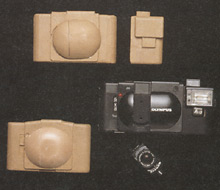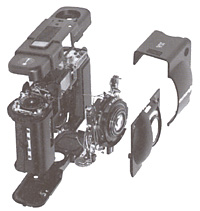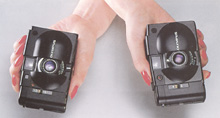 |
||
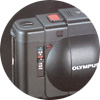 |
Normally, authorization from the management was needed before the development of a product could be started. However, with his strong sense of mission, Maitani had already initiated a project on a new camera - XA. In the winter of 1977, the photographic industry was stunned with the release of Konica C35AF, the world's first compact AF camera. To meet with the competition, the management of Olympus was impatiently waiting for a new camera. It was in this circumstance that XA was presented to the Olympus management for approval.
Maitani thinks that there are many circumstances that one would not take a camera with. For example, carrying a SLR in a party. However, there are many opportunities for taking photographs in these situations. XA is developed to meet this need. |
   |
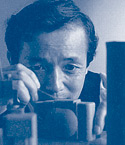 |
||
|
The design of XA was unique at the time of its introduction. The rounded edges and the streamlined bulge at the middle give XA a distinctive look - a combination of cutting-edge and fondness. Before XA, cameras have a cool and overbearing image that turns off non-technically minded and women users and the subjects that are being photographed. In general, males like mechanical things and cameras with mechanical features sell well. Camera designers have to design cameras with lots of mechanical features. This is the accepted wisdom. Maitani wanted to break this wisdom. He wanted to create a camera with no mechanical features visible on its exterior. A Dust Barrier is used to slide across the front of the body horizontally to protect the lens, viewfinder and eyepiece. This barrier also acts as a case and the on/off switch. The capless and caseless design eliminates
one of the nuisance of photo-taking that annoys many casual photographers. The Dust Barrier concept is still used in the current Olympus 35mm, APS and digital cameras. Maitani wanted
the camera to feel like a ceramic art object. A special surface finish
is applied to the body to give it a stone-like feel. |
|
The unique shape
of XA was designed by Maitani himself. To make an ideal camera body,
Maitani painstakingly worked on a clay model at his home till midnight.
Working with a
clay model involved making endless fine alternations and then gazing
at it for a long time. When the clay model didn't look right however
many alternation and retouching had been made, it was time to start
afresh with a new model. When a new model was finished, it was compared
with its predecessor. Using the conventional
two opposed mold sections to cast the plastic Dust Barrier was impossible.
It was because of the delicate and complicated curved shape of the Dust
Barrier and the clasp-like extrusions needed for the opening and closing
sliding action.
|
|
To design a lens
that can be fitted to the compact dimension of the XA body was one of
the hardest problem of the XA development. Maitani insisted on a 35mm lens to be fitted into a body of 4cm thick. However, only a 31mm wide angle lens can be fitted into it by using the conventional design concept. Moreover, by shortening a Tessar type 35mm lens, the maximum shortening achieved is 1mm and not the required 4mm. The lens design team headed by Yoshisada Hayamizu finally came up with the idea of using a "Reverse Retrofocus Type" or "Telephoto Type" lens design. It was the first time that a "Reverse Retrofocus Type" 35mm wide angle lens was designed. (Normally, this type of lens design was used to make telephoto lens for SLR.) To provide focusing without extending the lens outward, an inner focusing mechanism was adopted. |
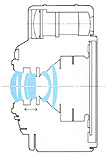 |
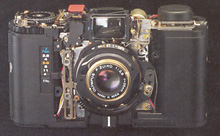 |
The wide shutter speed range of XA (1/500 sec - 10 sec) called for a mechanism of unusually high precision. It was found that the magnet used for opening the shutter needed to be very small, reliable and durable. However, such kind of magnet could not be found in existing products. After consulting specialist magnet manufacturers one after another, a magnet made of rare earth material was found suitable. "X" is the most
distinctive sounding letter in the English alphabet, and it conveys
a futuristic and leading- edge technology image. "A" is chosen for no particular reasons except it goes well with the "X" and it offers the nuances of "Number 1". Around the time XA was introduced, production of new camera models was started at a rate of five or ten thousands units a month. However, XA was produced at a rate of 20,000 units a month. Later, it was raised to 30,000 units a month.
|
 |
|
|
I: Olympus changed the fixed idea of "cameras are big and heavy" and presented the new value of "compactness" for photographers. It was your achievement. Even so, recent products are not compact. M: Will you please use "were" instead. Currently, the [mju:] is compact. (bitter smile) I: The [mju:] is OK. But other products are not… M: At the beginning when I became the Director of the whole business, some products were not compact. But now, the matter has been reformed. S: Carelessness deviates our products from the philosophy of compactness like that big FTL. A compact camera becomes bigger and bigger with new technologies. But an antithesis slaps engineers’ faces and the camera becomes compact again. This happens all the time. I: The XA was developed under the concept of caseless. Why did you take that way? M: Originally,
caseless is not important for the XA concept. The concept was a small-sized
camera. Whether caseless or not, the goal was,
this is my lifelong theme, a pocketable camera that can be carried anywhere.
One day, I was invited to a press discussion after we announced the XA. I went there but I had nothing in my hand. The press members asked me why I didn’t bring the camera. I quickly took out the camera from my pocket. I: It is an affected way. M: It was the starting point. When I tried to refine the concept, I found that a camera case was unwieldy. Then I designed the lens barrier to protect the lens and viewfinder from dust. Capless and caseless are the consequences of realizing in-pocket concept. |


|
| XA | photo | catalog | advertisement | test report |
| chrono
| young Maitani | joining
Olympus | philosophy | anecdotes
l Maitani adv | Pen
|
OM | XA | photo
|
